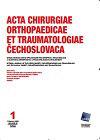[关于腕关节囊血管的近端行腕关节切除术中的关节置换术技术优化:尸体研究]。
IF 0.4
4区 医学
Q4 ORTHOPEDICS
Acta chirurgiae orthopaedicae et traumatologiae Cechoslovaca
Pub Date : 2023-11-11
DOI:10.55095/achot2023/040
引用次数: 0
摘要
研究目的 该研究旨在提出一种最佳的腕背关节囊创建方法,以确保关节置换术的长期存活。材料和方法 从 16 具尸体(死亡时年龄介于 18 岁至 80 岁之间,腕部无明显病变)上共采集了 28 个腕关节背囊。从这 28 个样本中共获得 112 份组织学标本。在 0.05 的显著性水平下,采用事后邓恩检验分析背囊各侧血管化的百分比(周长和面积)。斯皮尔曼相关分析用于评估年龄对腕关节背囊血管化的影响。对同时采集到两个腕背囊的尸体肢体进行比较。为了进行比较,使用了 Wilcoxon 配对检验。结果 在统计意义上,腕背囊测量血管的总周长和总面积中,远侧所占比例最大(占周长的 35.2%,占面积的 30.9%)。尺侧背囊获得的血液供应最少(占周长的 12.9%,占面积的 17.6%)。年龄对腕关节背囊血管化没有明显影响。此外,对来自一具尸体的双侧肢体的血管化情况进行比较也没有得出任何有统计学意义的结果。讨论 近端行腕关节切除术是一种历史悠久的外科技术,用于治疗腕关节退行性病变。我们的结果表明,腕背囊远端和桡侧的血管生成情况最好。有鉴于此,以远端为基础的Fl ap或Berger所描述的Fl ap,尊重临床上重要的韧带,似乎是创伤最小的,并有助于保持腕部未来的稳定性。结论 在临床实践中,我们建议按照 Berger 的方法创建以桡侧为基础的瓣膜,并尽可能保留背囊远侧(根据我们的结果,背囊是血管最丰富的部分)。这种方法还能保留重要的腕韧带,而且在本研究的作者看来,与远端相反,这种方法对最大动脉的存在也是最有益的。另一种选择是使用远端瓣进行关节间置换术。关键词:关节间置换术、近侧行carpectomy、血管化、退行性病变、腕关节。本文章由计算机程序翻译,如有差异,请以英文原文为准。
[Technique Optimization of Interposition Arthroplasty During Proximal Row Carpectomy with Regard to the Vascularity of the Capsule in Carpal Joint: Cadaverous Study].
PURPOSE OF THE STUDY The study aimed to propose an optimal based fl ap creation with the view to ensure long-term survival of the interposition arthroplasty. MATERIAL AND METHODS A total of 28 dorsal wrist capsules were collected from 16 cadavers (with age range at death 18 to 80 years, with no visible wrist pathology). Altogether 112 histological specimens were obtained from these 28 samples. Post-hoc Dunn's tests were used to analyse the percentage of vascularisation of individual sides of the dorsal capsule (circumference and area) at the 0.05 level of signifi cance. Spearmann's correlation analysis was used to assess the effect of age on vascularization of the dorsal wrist capsule. In cadavers in whom both capsules were collected, the limbs were compared. For the sake of comparison, the Wilcoxon matched pairs test was used. RESULTS Regarding statistical signifi cance, the largest share of the total circumference and area of the measured vessels of the dorsal capsule is constituted by the distal side (35.2% of the circumference and 30.9% of the area). The blood supply of the dorsal capsule received on the ulnar side is the lowest (12.9% of the circumference and 17.6% of the area). There was no signifi cant effect of age on vascularization of the dorsal wrist capsule confi rmed. Also, the comparison of vascularization of both limbs from a single cadaver did not yield any statistically signifi cant results. DISCUSSION Proximal row carpectomy is a long-established surgical technique used to manage the degenerative changes in the wrist. Our results showed the best vascularization on the distal and radial sides of the dorsal wrist capsule. In this light, the distally-based fl ap or the fl ap described by Berger, which respects the clinically important ligaments, appear to be the least invasive and help maintain the future stability of the wrist. CONCLUSIONS In clinical practice, we advise that a radially-based fl ap according to Berger is created and the distal side of the dorsal capsule, the most vascularized portion based on our results, is preserved as much as possible. The fl ap created in this manner also preserves the important carpal ligaments and appears to the authors of this study to be the most benefi cial, also with respect to the presence of the largest arteries, contrary to the distal side. Another option is to use a distally-based fl ap for interposition arthroplasty. Key words: interposition arthroplasty, proximal row carpectomy, vascularization, degenerative changes, wrist.
求助全文
通过发布文献求助,成功后即可免费获取论文全文。
去求助
来源期刊
CiteScore
0.70
自引率
25.00%
发文量
53
期刊介绍:
Editorial Board accepts for publication articles, reports from congresses, fellowships, book reviews, reports concerning activities of orthopaedic and other relating specialised societies, reports on anniversaries of outstanding personalities in orthopaedics and announcements of congresses and symposia being prepared. Articles include original papers, case reports and current concepts reviews and recently also instructional lectures.

 求助内容:
求助内容: 应助结果提醒方式:
应助结果提醒方式:


